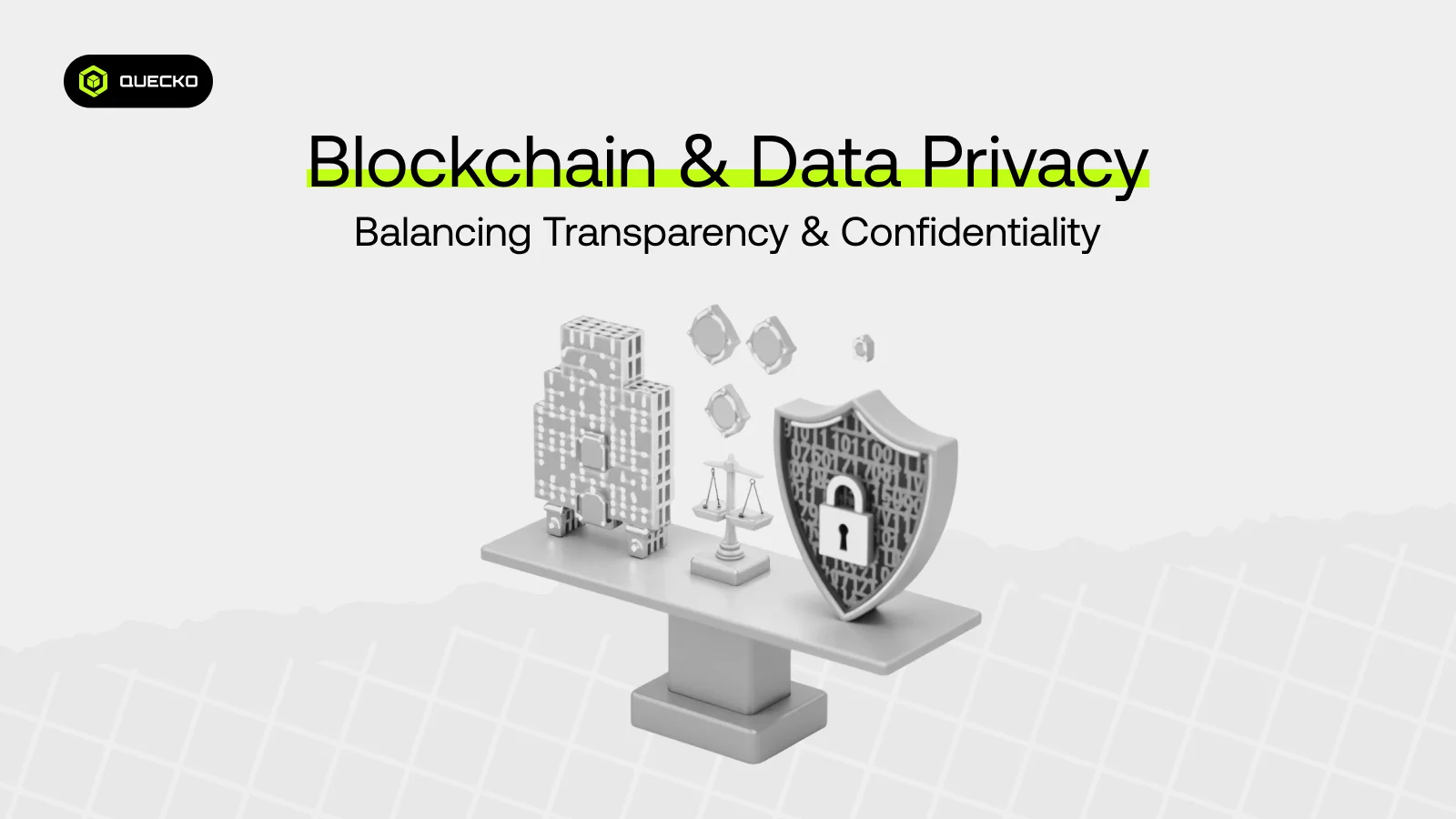Blockchain and Data Privacy: Balancing Transparency and Confidentiality
Blockchain technology meets data privacy with smart contracts, selective disclosure, and secure computation.

Blockchain technology has transformed industries with its decentralized, immutable, and transparent framework. From digital currencies to complex supply chain ecosystems, its power lies in trust without intermediaries, and the rise of smart contracts has only amplified its capabilities. But as more organizations turn to public blockchain networks for openness and accessibility, concerns over data privacy have intensified.
How can a system designed for visibility also safeguard sensitive information? This blog explores private blockchain, where transparency meets confidentiality in a digital-first world.
The Transparency vs. Privacy Paradox
Blockchain technology has ushered in a new era of decentralized trust, offering a distributed ledger system that records transactions immutably and transparently. This innovation has transformed industries such as finance, healthcare, and supply chain management, enabling secure and verifiable data exchange without the need for intermediaries. However, the very transparency that makes public blockchains so powerful also introduces significant challenges around data privacy.
Blockchain’s Transparent Nature
Most public blockchains, such as Bitcoin and Ethereum, are permissionless and open to anyone. This means:
- Every transaction is permanently recorded on the distributed ledger
- Anyone can verify the integrity of the data
- Users are identified by wallet addresses, offering pseudonymity rather than true anonymity
This transparency helps prevent fraud and fosters trust. However, it also creates vulnerabilities:
- Businesses may face competitive risks if rivals analyze transaction flows
- Individuals could have their identities linked to wallet addresses, compromising user data privacy
Although blockchain technology is designed to be secure, the exposure of transactional metadata can lead to unintended consequences, particularly when sensitive information is involved.
The Need for Confidentiality
Industries such as healthcare, finance, and government require robust data privacy protections. The General Data Protection Regulation (GDPR) requires that:
- The individual should control user data
- Personal data is erasable, a challenge on immutable blockchains
- Only essential data should be stored and processed
Traditional public blockchains struggle to meet these requirements due to their permanent and transparent nature. This has led to the rise of permissioned blockchains, which offer more control over access and visibility. These private networks allow organizations to:
- Restrict who can view or modify data
- Implement smart contracts with privacy-preserving logic
- Comply with data protection regulations while still leveraging the benefits of blockchain technology
By integrating permissioned blockchain models and advanced cryptographic techniques, businesses can strike a balance between transparency and confidentiality, ensuring that user data remains protected while maintaining the integrity of the distributed ledger.
How Blockchain Can Enhance Data Privacy
As blockchain technology continues to reshape industries with its decentralized and transparent architecture, the challenge of maintaining data privacy within public blockchain environments becomes increasingly critical. While transparency fosters trust and accountability, it can also expose sensitive information, leading to potential data breaches and regulatory concerns. Fortunately, several innovative solutions are emerging to reconcile this paradox and strengthen privacy protections.
1️⃣ Zero-Knowledge Proofs (ZKPs)
What it does: Zero-Knowledge Proofs allow one party to prove possession of certain information without revealing the actual data. This cryptographic method ensures that transactions can be validated without compromising privacy.
Example: Zcash utilizes zk-SNARKs (Succinct Non-Interactive Argument of Knowledge) to enable private transactions while preserving the integrity of the public blockchain.
Why it matters: ZKPs are a powerful encrypted technique that supports privacy-preserving smart contracts, enabling secure interactions without exposing user data.
2️⃣ Private and Permissioned Blockchains
What it does: Unlike public blockchains, permissioned blockchains restrict access to authorized participants. Platforms like Hyperledger Fabric and R3 Corda enable enterprises to share data within a controlled environment securely.
Use case: In sectors like healthcare and finance, organizations can collaborate using smart contracts while ensuring compliance with data privacy regulations.
Why it matters: Permissioned networks reduce the risk of data breaches by limiting visibility and access, making them ideal for sensitive applications.
3️⃣ Off-Chain Data Storage
What it does: Sensitive information is stored outside the blockchain (e.g., using IPFS or decentralized cloud storage), while only cryptographic hashes are recorded on-chain to verify integrity.
Example: Encrypted medical records can be stored off-chain, with blockchain ensuring tamper-proof verification through hash references.
Why it matters: This approach minimizes on-chain exposure of user data, striking a balance between transparency and confidentiality in blockchain technology systems.
4️⃣ Homomorphic Encryption
What it does: This advanced, encrypted technique enables computations to be performed directly on encrypted data without requiring it to be decrypted first.
Use case: In secure voting systems, votes remain encrypted throughout the process, yet can still be accurately tallied, preserving both privacy and trust.
Why it matters: Homomorphic encryption supports privacy-preserving analytics and decision-making, especially in multi-stakeholder environments.
5️⃣ Mixing and CoinJoin Techniques
What it does: These methods obscure transaction trails by combining multiple transactions into a single batch, making it difficult to trace individual transactions and their inputs and outputs.
Example: Bitcoin’s Wasabi Wallet uses CoinJoin to enhance anonymity and reduce traceability on the public blockchain.
Why it matters: Such techniques help protect user data from surveillance and profiling, reinforcing the privacy layer of blockchain technology.
6️⃣ Multi-Party Computation (MPC)
What it does: MPC enables multiple parties to jointly compute a function using private inputs, without revealing those inputs to each other.
Use case: In collaborative environments such as financial forecasting or medical research, MPC enables secure data sharing and analysis.
Why it matters: MPC strengthens data privacy by ensuring that sensitive information remains confidential even during joint computations.
Challenges in Balancing Privacy & Transparency
While blockchain technology offers groundbreaking solutions for secure and decentralized record-keeping, achieving a balance between inherent transparency and data privacy remains a complex challenge, especially in the digital age, where sensitive information is constantly at risk.
1. Regulatory Compliance vs. Immutability
One of the most pressing issues is the conflict between blockchain’s immutable nature and global privacy regulations. Laws like the General Data Protection Regulation (GDPR) grant individuals the “right to be forgotten,” which requires the ability to delete personal data. However, ledger technology is designed to be permanent and tamper-proof, making data erasure nearly impossible.
This contradiction raises concerns for any blockchain platform user, in healthcare and finance. Off-chain solutions, where sensitive data is stored outside the blockchain, regulatory compliance remains a moving target.
2. Scalability of Privacy-Enhancing Technologies
Advanced encryption techniques such as Zero-Knowledge Proofs (ZKPs), multi-party computation, and end-to-end encryption offer promising ways to protect confidential transactions. However, these methods often come with high computational costs, which can hinder scalability.
For example, implementing ZKPs on a large-scale public blockchain may slow down transaction speeds and increase resource consumption, making it less practical for high-volume applications such as supply chain management or digital payments.
3. User Education and Awareness
Despite the growing adoption of blockchain platforms, many users still lack a clear understanding of how data privacy works in decentralized systems. Simple actions, such as reusing wallet addresses, can lead to data breaches through deanonymization, where pseudonymous identities are linked to real-world individuals.
Educating users about best practices, such as using privacy wallets or rotating addresses, is essential to prevent unintended exposure of confidential transactions and personal data.
4. Trade-offs Between Privacy and Trust
Increasing privacy often means reducing the level of transparency, which can undermine the very trust that blockchain is built upon. For instance, fully private transactions may be more difficult to audit, raising concerns in sectors that rely on transparency and accountability.
Striking the right balance requires thoughtful design: integrating off-chain solutions, permissioned access, and selective disclosure mechanisms that preserve trust while protecting sensitive information.
In summary, while blockchain technology holds immense promise, navigating the tension between transparency and privacy demands ongoing innovation, user education, and regulatory alignment. Only then can we build systems that are secure, scalable, and respectful of individual rights in the digital age.
The Future: Privacy-Preserving Blockchains
As blockchain technology matures, the blockchain community is increasingly focused on solving one of its most pressing challenges: how to preserve data privacy without compromising the inherent transparency that makes blockchain so powerful. The future of blockchain lies in developing systems that enable secure, private, and scalable solutions for industries ranging from finance to healthcare.
Confidential Smart Contracts
Confidential smart contracts are emerging as a transformative solution. Platforms like Oasis Network are pioneering private computations that allow sensitive logic and data to remain hidden while still executing on-chain.
- These contracts operate on environments like the Ethereum Virtual Machine (EVM), which enables the decentralized execution of code across multiple nodes.
- By integrating secure multi-party computation, confidential smart contracts can process private inputs from multiple parties without revealing them, making them ideal for business transactions involving proprietary data.
This innovation ensures that contracts remain verifiable and enforceable while protecting the confidentiality of participants.
Self-Sovereign Identity (SSI)
Self-Sovereign Identity empowers individuals to control their data using blockchain technology, enabling them to take ownership of their digital identity. Instead of relying on centralized identity providers, users can manage credentials and selectively share information.
- SSI leverages selective disclosure, allowing users to reveal only the necessary data for a given interaction.
- This is especially valuable in the healthcare system, where patients can securely share medical records without exposing their entire medical history.
SSI represents a shift toward user-centric privacy, aligning with global data protection standards.
Hybrid Blockchains and Chain Storage
Hybrid blockchains combine the openness of public blockchains with the control of private networks, offering a balance between the two. This architecture enables selective transparency, where certain data is visible to all, while sensitive information is restricted to authorized parties.
- Hybrid models often use chain storage techniques that separate public and private data layers.
- For example, public hashes may verify the integrity of off-chain data, while private nodes manage confidential records.
This approach is ideal for enterprises conducting business transactions that require both auditability and discretion.
What’s Next for the Blockchain Community?
The future of blockchain will be shaped by continued innovation in privacy-preserving technologies. As platforms like Ethereum evolve, enhancements to the Ethereum Virtual Machine will support more advanced privacy features, including:
- Secure multi-party computation for collaborative analytics
- End-to-end encryption for smart contract interactions
- Scalable chain storage solutions for hybrid data models
Together, these trends point toward a blockchain ecosystem that is not only transparent and decentralized but also deeply respectful of privacy, a critical requirement in the digital age.
Conclusion
Blockchain’s transparency is a double-edged sword, essential for trust but challenging for privacy. By leveraging zero-knowledge proofs, private chains, and encryption, the technology can evolve to meet both needs.
The future lies in flexible, privacy-aware blockchain solutions that comply with regulations while preserving the core benefits of decentralization.
Date
4 months agoShare on
Related Blogs

The Hurdles to a Truly Decentralized Exchange Future
4 days ago

Smart Contracts vs Traditional Contracts: What Businesses Need to Know
19 days ago

From Texts to Trust: How Blockchain Makes Messaging Safer
27 days ago

Bitcoin vs Gold: Is the Comparison Still True in 2025?
1 month ago








